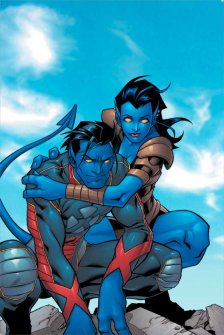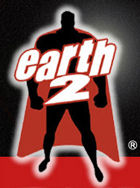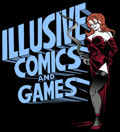Exiles #30
writer: Chuck Austen
artists: Clayton Henry and Mark Morales
You really want to know why this arc has
been bad? It's not so much that the Exiles meet "our" X-Men,
because heck, that makes it more of a twisted Marvel version
of the JLA/JSA crossovers from the sixties.
To make sense of the storyline, Austen assumes
you've been reading his run on Uncanny X-Men. Though
this title usually takes time to establish the status quo
that the Exiles have to ruin, Austen never really bothers.
There's an apparently non-mutant woman staying at the mansion,
one that so far hasn't seemed to show up in New X-Men.
She's a major character, and yet it's not important for us
to really know who she is.
Maybe that's quibbling, but it's almost a
theme to Austen's run. Action overrides plot which overrides
characterization. Even if you do care what's happening, the
writing doesn't make it easy.
An evil version of Alex tries to kill two
young boys? All in a day's work for the X-Men, apparently.
(Okay, maybe Austen has a point there.) But Nocturne has spent
almost the entire series pining for her lost father, and when
she finds an alternate version, it's shunted off to just a
couple of panels. Worse, Kurt even considers looking up the
Scarlet Witch.
The only character in character is Morph,
either because he's too easy to write or because, well, he's
so well-established only an idiot could mess it up.
Though the Henry and Morales art team isn't
one of my favorites, they do a decent job. If only everybody
didn't look like they'd walked off Battle of the Planets…
Rating: 
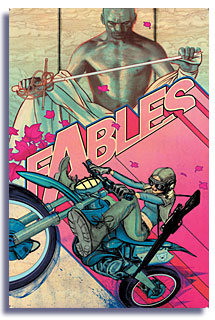 Fables
#16
Fables
#16
writer: Bill Willingham
artists: Mark Buckingham and Steve Leialoha
Stuck in the woods, stalked by a psychotic
Goldilocks, it's about high time that Snow White and Bigby
Wolf sorted out their feelings for each other. Sure, in high
concept it sounds silly, but Buckingham and Leialoha keep
both characters looking appropriately tense and quite unglamorous.
Even before his full transformation into giant wolf, Bigby
looks far more feral than usual.
Willingham digs even deeper into the fairy
tales, pulling out backgrounds that few outside of literary
scholarship would be aware of. It doesn't seem pretentious;
it just makes it richer.
And speaking of richer, Prince Charming takes
on Bluebeard in an unexpected duel. Fueled by a combination
of noble and greedy intentions, the Prince intends for only
one fable to walk away.
And then a flying monkey decides that in
the absence of anyone else in the Mayor's office, he must
be in charge.
That this book can and should be taken seriously
is a credit to the imagination and skill of all the creative
team. Willingham continually makes these characters seem real,
just of unreal origins. It's more than "spot the fairy tale;"
Fables is a compelling story in its own right.
Rating: 
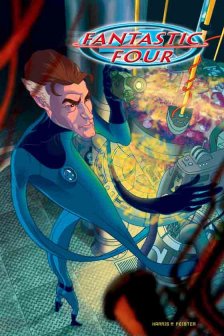 Fantastic
Four #502 (73)
Fantastic
Four #502 (73)
writer: Mark Waid
artist: Casey Jones
Let us not give Mark Waid a free pass to
the end of his run, just because it has been stellar and we
know it must end. All things must end.
No, make Waid continue to earn his praise.
Luckily, it seems the easiest thing in the world for him to
do.
With this issue, Waid continues having Reed
Richards do the "unthinkable," but what he's actually trying
to accomplish isn't yet clear. It is clear, however, that
something deep inside Mister Fantastic has been broken by
Doom. The sorcerous mark on his face is the least of it.
Internalizing the changes, too, is Franklin
Richards, whom Waid portrays as being smart, but realistically
so for a small child. (How old is Franklin supposed to be?
Has he moved beyond being four?) Despite his having returned
to Earth, Franklin has learned not to trust safety. Really,
how are you supposed to calm a child who has literally been
in Hell?
The answer may surprise you, and allows Waid
to give center stage to The Thing. As has happened issue after
issue, the writer manages to focus on a facet of characterization
in such a way as to make it seem new. Or rather, old, because
all of this was present in Lee and Kirby's original run; we'd
just forgotten.
Subbing in for Mike Wieringo, Casey Jones
has a similar look, but he's not quite the draftsman Wieringo
is. It's not jarring; it's just a little more stiff, and yes,
a little more manga. Perhaps Marvel is trying to adopt a house
style. If so, it doesn't quite work.
Rating: 
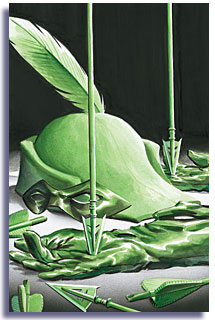 Green
Arrow #29
Green
Arrow #29
writer: Judd Winick
artists: Phil Hester and Ande Parks
After Kevin Smith redefined Green Arrow's
place in the DC Universe, Brad Meltzer started reclaiming
the character's place in his own life. So what's left for
Judd Winick to do? Try to deal with why superheroes should
bother dressing up at all, when the real villains won't return
the favor.
It's a theme that Mike Grell explored in
the eighties with his take on the character, but that quickly
became more what you might call "men's adventure" rather than
still exist comfortably as a superhero story. So far, though,
Winick seems to keeping the balance.
Facing down inhuman monsters (gargantuan
beasts and one cold-blooded professional killer), Ollie wishes
for something simpler, like Heat Wave or The Monocle - "…at
least you could see them coming."
But since his return, things haven't been
simple. Even his old behaviors haunt him in ways they never
did. For those who wondered how he could sleep with Joanna
Pierce when he's supposedly back with Black Canary, it's clear
that Ollie wonders, too. He's not comfortable with the answer.
There may be a place for Green Arrow in Oliver
Queen's life; it's Oliver who doesn't seem to fit anymore.
Once again, Hester and Parks deftly illustrate
Winick's script; something about their art seems to keep the
writer from getting too glib. In this team's hands, Green
Arrow may not be a high profile book anymore, but it's
still good.
Rating: 
